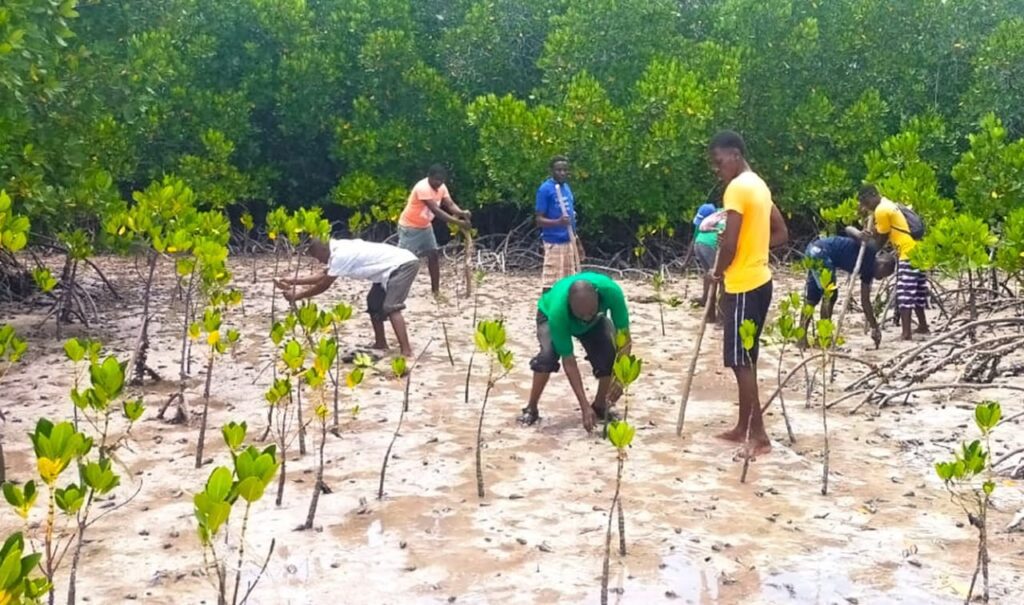Gazi conservation group planting mangrove tree seedlings.
Residents of Gazi in Kwale County, Kenya, are transforming their livelihoods and environment by restoring the once-depleted mangrove forests. “We are making more money from planting trees than we used to make from cutting trees,” Jilo Baya, a community member, tells us. Located 50 kilometres south of Kenya’s coastal city of Mombasa, the Gazi community is on a mission to restore an extensive mangrove forest once threatened by them. So far, they have restored 615 hectares. The dense mangrove forest is a blue-carbon ecosystem, which means that it captures and stores vast amounts of carbon. It’s also critical to the marine ecosystem around which the lives of Gazi people revolve. However, the locals have not always been conservationists. Over the decades, encroachment by the Indian Ocean and increased temperatures disrupted fishing, the main economic activity of the Gazi people, and they resorted to harvesting mangrove trees, which they sold as a building material and wood fuel.
According to Kenya Marine and Fisheries Research Institute (KMFRI) principal scientist Kipkorir Langa’t, Kenya lost 20 per cent of its mangroves between 1985 and 2009. But this changed with the launching of Mikoko Pamoja in 2013, a community conservation movement to restore and protect the forest. Mikoko Pamoja is the world’s first mangrove-driven carbon credit initiative. Mikoko Pamoja adopted carbon offsetting to pull the community towards owning the Gazi mangrove forest restoration drive. The Gazi are now making money through the sale of carbon credits. Carbon credits are permits, common in the US and Europe, that provide for the owner to emit a certain amount of carbon dioxide or other greenhouse gas. They can be traded to benefit entities working to reduce carbon dioxide emissions. The trading system has suffered due to the subjective nature of carbon offset determinations and because many countries still lack the regulatory framework needed to drive carbon pricing.
However, these issues are being addressed and Africa is seen as an untapped market for carbon trading. Mikoko Pamoja’s chairperson, Ismail Barua notes that the Gazi community is “killing many birds” with one stone through the project. “On one hand, they are restoring a very critical forest. On the other hand, they are earning money while at the same time, fighting poverty and restoring fishing and tourism trades, which were once dead,” says Barua. He adds that the community is entirely in charge of three essential aspects of the project: forest restoration, management and conservation. Rahma Kivugo, Mikoko Pamoja project coordinator, says the community has so far planted 56,000 seedlings and has a work plan of planting at least 2,000 per year. “The Gazi Forest absorbs carbon at a rate of 3,000 metric tons per year. Carbon level testing is done twice yearly on 15 selected 10-square-meter plots in the forest. Experts measure the diameter of mature trees at an adult’s chest height. The tree’s height is then measured, and finally, classification is done depending on the height of the trees,” she explains. Kivugo adds that researchers then use the results to estimate the volume of mangrove material above ground in each plot and extrapolate for the whole forest area.
According to Kivugo, some 117 hectares of Gazi Forest have been restricted for the sale of carbon credits. Anthony Mbatha of Kenya Marine and Fisheries Research Institute (KMFRI) says once an estimate of the plant material above ground has been established, experts move to estimate root volume below ground using a standardised factor specific to mangrove forests. “Ideally, 50 per cent of aboveground biomass is carbon. Below ground, 39 per cent of biomass is carbon,” says Mbatha. After establishing the amount of carbon stored by Gazi Forest, the data is relayed to the Plan Vivo Foundation group in Scotland for certification. The foundation then issues Plan Vivo Certificates (PVCs) to the community through Mikoko pamoja.
Mbatha explains that one PVC is equivalent to one metric ton of carbon dioxide emission reductions. Mikoko pamoja then hands the PVCs to the Association for Coastal Ecosystem Services – an organisation that markets carbon credits on its behalf. Mikoko Pamoja sells carbon credits at more than US$7 per ton. “The forest project generates approximately US$15,000 annually from the sale of carbon credits. In total, the community has received US$117,000 from the sale of carbon credits since 2014”, Kivugo said. From 2014 to 2018, the Gazi project generated 9,880 credits, translating to 9,880 tons of avoided carbon dioxide emissions. To enhance the protection of the mangrove ecosystem, Kenya included mangroves and seagrasses in her Nationally Determined Contributions (NDCs) IN 2020. NDCs are greenhouse gas emission reduction commitments for countries that ratified the Paris Agreement. Kenya also approved the Forest Conservation and Management Act of 2016, a law protecting mangroves and inland forests.
Source: bird story agency



